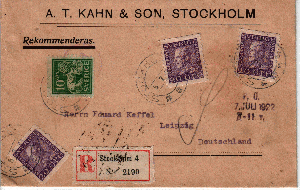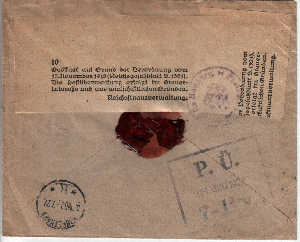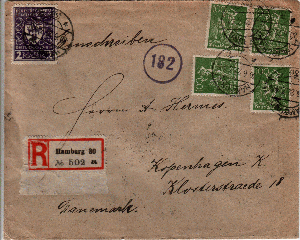@ 22028
[#111]@ Concordia CA
[#34]Hier die Antwort von Robin.
Dear Nigel
The Exchange Control did not open every letter. I have seen a report
from archives which suggests that less than half the letters were
actually opened. Those they did not open were usually marked in some way
to show that had been seen but unopened. Often this was no more than the
inspector's personal numeral cachet. Occasionally a special cachet was
used including the word Freigegeben.
The item from Colombia has the inspector's personal cachet number 136 in
a circle on it. The 3 line date cachet of 12 July 1922 in blue is
typical of the Hamburg Exchange Control from July 1922 to November 1923.
The colour of ink used for the date changed each day on a three colour
cycle. The colours used were usually red, green, blue in that sequence
although yellow was used on 25 Oct 1922 (instead of blue) and again on 3
Nov 1922 (again instead of blue). Black is also sometimes used instead
of blue.
At some Exchange Control Offices the Post Office postmarked the mail
before giving it to the Exchange Control and after receiving it back.
Where this did not happen Der Reichsminister der Finanzen in a letter
reference III R 1300 2.5.22 required the date of entry and exit to be
given by the Exchange Control Office where not provided by the Post
Office. They also required the colour of ink used to change each day on
a 2, 3 or 4 day cycle. In practice these instructions were not carried
out in full.
The date of 12 July is very early for this cachet. The earliest cover I
have with this cachet is dated 7 July 1922 struck in purple (rather than
red).
A different much larger date time cachet was used on 1 July 1922 between
7 and 11 in the morning. So far no other dates or times of use of this
larger cachet are known. I have also not succeeded in finding any covers
that went through the Hamburg Exchange Control from 2 July to 6 July.
You also ask were some firms and individuals treated as
'unobjectionable' implying that mail to or from them was not opened. I
certainly have evidence that exports from major stamp dealers were
sometimes not opened but they would have been required to attach 2 forms
to their letters. These were :
Ausfuhrerklärung (Für Zwecke der Deutschen Zollabfertigung)
Statistik des Warenverkehrs. Anmeldeschein für die Ausfuhr von Waren
aus dem freien Verkehre des Zollgebiets.
This last form was removed by the Exchange Control and sent on a daily
basis to the Statistische Reichsamt in Berlin. Presumably if companies
were found to complete these forms accurately, then in future there was
little risk in only opening a sample rather than opening everyone.
Robin



I attach scans of the two covers I mention.
Hamburg 30 dated 30.6.22 via Hamburg PUe 1.7.1922 (large date time
cachet on back) to Copenhagen 2.7.22 with inspector's cachet 182 on
front and sealing label on back.
Stockholm dated 5.7.22 via Hamburg PUe 7.7.1922 (small date time cachet
on front) to Leipzig 8.7.22 (on reverse not shown). This was not opened
by the Exchange Control and does not bear an inspector's personal cachet.
My questions are :
1) was the large date time cachet used after 11am on 1.7.1922 and was it
used in June 1922 ?
2) does anyone have an earlier date for the small date time cachet ?
3) what was done from 2 July to 6 July ? Was the date written in
manuscript or was no date cachet used ?